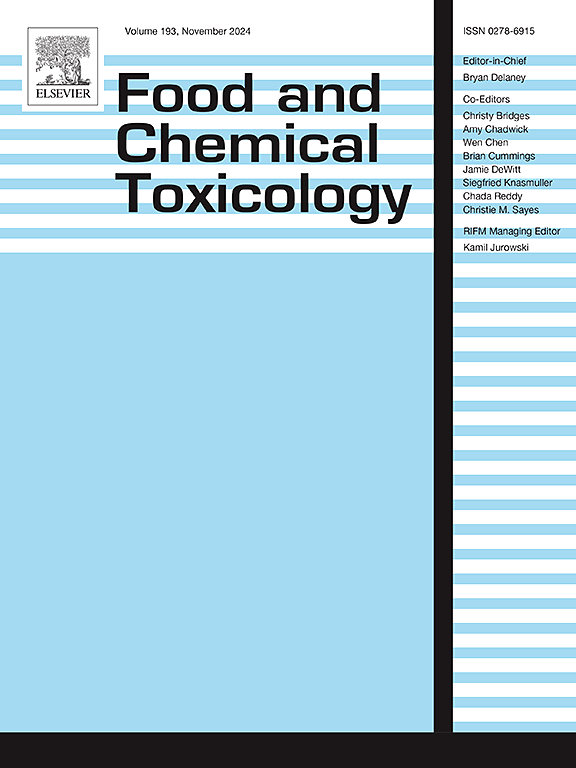Mn2O3 nps诱导的肉鸡肝损伤可能与肠道菌群失调有关
IF 3.9
3区 医学
Q2 FOOD SCIENCE & TECHNOLOGY
引用次数: 0
摘要
Mn2O3纳米颗粒(Mn2O3 NPs)是一种新型材料,在医学、电化学传感和储能等领域有着广泛的应用。Mn2O3 NPs的广泛使用引起了健康问题,有必要阐明Mn2O3 NPs暴露的毒性机制。研究结果表明,Mn2O3 NPs暴露可导致肝脏组织学异常,肝脏线粒体功能障碍,以及线粒体介导的细胞凋亡、自噬和线粒体动力学紊乱,最终导致肝脏损伤。同时,Mn2O3 NPs暴露后,回肠上皮受到生理损伤和炎症反应,肠道屏障功能相关基因和蛋白MUC1、ZO-1、Claudin1和Occludin的表达水平显著下调。同时,肠道细菌的16s测序分析表明,Mn2O3 NPs暴露导致肠道菌群丰度发生显著变化。厚壁菌门/拟杆菌门比值升高,益生菌(拟杆菌、双歧杆菌、粪杆菌)丰度降低,有害菌(链球菌、肠球菌、假单胞菌)丰度升高。这些菌群的变化可能潜在地影响肝损伤的发展。总之,这些结果为肠道微生物群通过肠-肝轴诱导Mn2O3 NPs相关肝毒性的潜在机制提供了新的见解,并有助于更好地解释Mn2O3 NPs对健康的影响。本文章由计算机程序翻译,如有差异,请以英文原文为准。
Mn2O3 NPs-induced liver injury is potentially associated with gut microbiota dysbiosis in broiler chicken
Mn2O3 nanometer particles(Mn2O3 NPs), a new material, is widely used in medicine, electrochemical sensing and energy storage fields. The widespread use of Mn2O3 NPs has caused health concerns, and it is necessary to clarify the toxic mechanism of Mn2O3 NPs exposure. Our findings showed that Mn2O3 NPs exposure could lead to liver histological abnormalities, mitochondrial dysfunction in liver, as well as mitochondrial-mediated apoptosis, autophagy and mitochondrial dynamics disorder, and eventually lead to liver injury. At the same time, the ileal epithelium suffered physiological damage and inflammation after Mn2O3 NPs exposure, and the expression levels of genes and proteins related to intestinal barrier function (MUC1 ZO-1 Claudin1 and Occludin) were significantly down-regulated. Meanwhile, 16s sequencing analysis of intestinal bacteria showed that Mn2O3 NPs exposure caused significant changes in intestinal flora abundance. The Firmicutes/Bacteroidetes ratio increased, and the abundance of probiotics (Bacteroides, Bifidobacterium, Faecalibacterium) decreased, while the abundance of harmful bacteria (Streptococcus, Enterococcus, Pseudomonas) increased. The changes in these microflorae may potentially impact the development of liver injury. Altogether, these results provide novel insights into the potential mechanism of Mn2O3 NPs related hepatotoxicity induced by gut microbiota via the gut-liver axis, and contribute to a better interpretation of the health impact of Mn2O3 NPs.
求助全文
通过发布文献求助,成功后即可免费获取论文全文。
去求助
来源期刊

Food and Chemical Toxicology
工程技术-毒理学
CiteScore
10.90
自引率
4.70%
发文量
651
审稿时长
31 days
期刊介绍:
Food and Chemical Toxicology (FCT), an internationally renowned journal, that publishes original research articles and reviews on toxic effects, in animals and humans, of natural or synthetic chemicals occurring in the human environment with particular emphasis on food, drugs, and chemicals, including agricultural and industrial safety, and consumer product safety. Areas such as safety evaluation of novel foods and ingredients, biotechnologically-derived products, and nanomaterials are included in the scope of the journal. FCT also encourages submission of papers on inter-relationships between nutrition and toxicology and on in vitro techniques, particularly those fostering the 3 Rs.
The principal aim of the journal is to publish high impact, scholarly work and to serve as a multidisciplinary forum for research in toxicology. Papers submitted will be judged on the basis of scientific originality and contribution to the field, quality and subject matter. Studies should address at least one of the following:
-Adverse physiological/biochemical, or pathological changes induced by specific defined substances
-New techniques for assessing potential toxicity, including molecular biology
-Mechanisms underlying toxic phenomena
-Toxicological examinations of specific chemicals or consumer products, both those showing adverse effects and those demonstrating safety, that meet current standards of scientific acceptability.
Authors must clearly and briefly identify what novel toxic effect (s) or toxic mechanism (s) of the chemical are being reported and what their significance is in the abstract. Furthermore, sufficient doses should be included in order to provide information on NOAEL/LOAEL values.
 求助内容:
求助内容: 应助结果提醒方式:
应助结果提醒方式:


